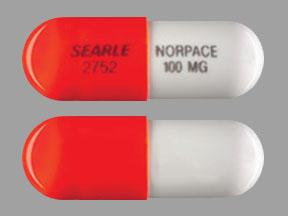Norpace Dosage
Generic name: DISOPYRAMIDE PHOSPHATE 100mg
Dosage form: capsule, gelatin coated
Drug class: Group I antiarrhythmics
Medically reviewed by Drugs.com. Last updated on Aug 4, 2025.
The dosage of Norpace or Norpace CR must be individualized for each patient on the basis of response and tolerance. The usual adult dosage of Norpace or Norpace CR is 400 to 800 mg per day given in divided doses. The recommended dosage for most adults is 600 mg/day given in divided doses (either 150 mg every 6 hours for immediate-release Norpace or 300 mg every 12 hours for Norpace CR). For patients whose body weight is less than 110 pounds (50 kg), the recommended dosage is 400 mg/day given in divided doses (either 100 mg every 6 hours for immediate-release Norpace or 200 mg every 12 hours for Norpace CR). In the event of increased anticholinergic side effects, plasma levels of disopyramide should be monitored and the dose of the drug adjusted accordingly. A reduction of the dose by one third, from the recommended 600 mg/day to 400 mg/day, would be reasonable, without changing the dosing interval.
For patients with cardiomyopathy or possible cardiac decompensation, a loading dose, as discussed below, should not be given, and initial dosage should be limited to 100 mg of immediate-release Norpace every 6 to 8 hours. Subsequent dosage adjustments should be made gradually, with close monitoring for the possible development of hypotension and/or congestive heart failure (see Warnings).
For patients with moderate renal insufficiency (creatinine clearance greater than 40 ml/min) or hepatic insufficiency, the recommended dosage is 400 mg/day given in divided doses (either 100 mg every 6 hours for immediate-release Norpace or 200 mg every 12 hours for Norpace CR).
For patients with severe renal insufficiency (Ccr 40 ml/min or less), the recommended dosage regimen of immediate-release Norpace is 100 mg at intervals shown in the table below, with or without an initial loading dose of 150 mg.
|
Creatinine Clearance |
40–30 |
30–15 |
Less than 15 |
|
Approximate Maintenance-dosing interval |
q 8 hr |
q 12 hr |
Q 24 hr |
The above dosing schedules are for Norpace immediate-release capsules; Norpace CR is not recommended for patients with severe renal insufficiency.
For patients in whom rapid control of ventricular arrhythmia is essential, an initial loading dose of 300 mg of immediate-release Norpace (200 mg for patients whose body weight is less than 110 pounds) is recommended, followed by the appropriate maintenance dosage. Therapeutic effects are usually attained 30 minutes to 3 hours after administration of a 300-mg loading dose. If there is no response or evidence of toxicity within 6 hours of the loading dose, 200 mg of immediate-release Norpace every 6 hours may be prescribed instead of the usual 150 mg. If there is no response to this dosage within 48 hours, either Norpace should then be discontinued or the physician should consider hospitalizing the patient for careful monitoring while subsequent immediate-release Norpace doses of 250 mg or 300 mg every 6 hours are given. A limited number of patients with severe refractory ventricular tachycardia have tolerated daily doses of Norpace up to 1600 mg per day (400 mg every 6 hours), resulting in disopyramide plasma levels up to 9 mcg/ml. If such treatment is warranted, it is essential that patients be hospitalized for close evaluation and continuous monitoring.
Norpace CR should not be used initially if rapid establishment of disopyramide plasma levels is desired.
Transferring to Norpace or Norpace CR.
The following dosage schedule based on theoretical considerations rather than experimental data is suggested for transferring patients with normal renal function from either quinidine sulfate or procainamide therapy (Type 1 antiarrhythmic agents) to Norpace or Norpace CR therapy:
Norpace or Norpace CR should be started using the regular maintenance schedule without a loading dose 6 to 12 hours after the last dose of quinidine sulfate or 3 to 6 hours after the last dose of procainamide.
In patients in whom withdrawal of quinidine sulfate or procainamide is likely to produce life-threatening arrhythmias, the physician should consider hospitalization of the patient. When transferring a patient from immediate-release Norpace to Norpace CR, the maintenance schedule of Norpace CR may be started 6 hours after the last dose of immediate-release Norpace.
Pediatric Dosage
Controlled clinical studies have not been conducted in pediatric patients; however, the following suggested dosage table is based on published clinical experience.
Total daily dosage should be divided and equal doses administered orally every 6 hours or at intervals according to individual patient needs. Disopyramide plasma levels and therapeutic response must be monitored closely. Patients should be hospitalized during the initial treatment period, and dose titration should start at the lower end of the ranges provided below.
| Age (years) |
Disopyramide (mg/kg body weight/day) |
|---|---|
|
|
|
Under 1 |
10 to 30 |
|
1 to 4 |
10 to 20 |
|
4 to 12 |
10 to 15 |
|
12 to 18 |
6 to 15 |
Norpace CR capsules should not be used to prepare the above suspension.
More about Norpace (disopyramide)
- Check interactions
- Compare alternatives
- Pricing & coupons
- Reviews (2)
- Drug images
- Side effects
- During pregnancy
- Generic availability
- Drug class: group I antiarrhythmics
- Breastfeeding
- En español
Patient resources
Professional resources
Other formulations
Related treatment guides
See also:
Further information
Always consult your healthcare provider to ensure the information displayed on this page applies to your personal circumstances.


